
|
|
January 25, 2006: Features
Student
stages
The student arts scene isn’t what it
used to be
By Bridget Reilly Durkin ’07 and Mark F. Bernstein ’83
If getting an education at Princeton is like trying to take a drink from a fire hose, then sampling the current student arts scene might draw a similar comparison. Gone are the days when campus stages offered little more than the Triangle Show and whatever bands happened to be playing at the eating clubs (though both remain popular options). Since last winter, a Princeton task force appointed by President Tilghman has been discussing ways to enhance the arts at Princeton. But the campus already is experiencing a renaissance in the creative and performing arts — traditional and avant garde, as part of the curriculum and outside it, and at venues ranging from McCarter Theatre to the Frist Campus Center to the Scudder Plaza fountain outside Robertson Hall. The fountain? Read on.
Assistant professor Dan Trueman, right, works with Jason Yang ’09, a member of the Princeton Laptop Orchestra. The experimental group was created by Trueman and Professor Perry Cook as a freshman seminar last fall. (Denise Applewhite/Office of Communications)
Music is made during meetings of Freshman Seminar 175 — but it’s probably not the kind you ever have heard before. This is the Princeton Laptop Orchestra, or PLork. Taught jointly by Dan Trueman, assistant professor of music, and Perry Cook, associate professor of computer science, it is a mix of music and technology, score writing and code writing. A dozen students sit in a circle on cushions and tune what Trueman describes as “musical meta-instruments” — in this case, a laptop, a multichannel hemispheric speaker that looks like a set of hubcaps glued to a pentagon, and different control devices ranging from computer mouses to keyboards, with wires running everywhere. Beethoven this is not — it remains exceedingly difficult for computers to re-create the sounds of traditional instruments. Instead, students upload loops of drumbeats, whistles, and riffs of this and that, which they mix to form a new, different, and experimental whole.
“One of the main objectives of PLork,” Trueman explains, “is to discover ways of making music together that are impossible without computers. Aesthetically, we are open to anything, but the laptops and the programs we use have an enormous impact on the kind of music we can and will make.” A typical homework assignment requires students to attend a performance of the Princeton University Orchestra, and then to consider “the relationship between instrument design, composition, and performance. Can one compose without knowing the instruments involved? How important is it for the audience to be able to see and understand what the performers are doing at a performance?”
Bonus material online:
Watch PLork perform—click
here.
High Steppers, from left, Shekida Smith ’09, Adriana Bedney ’07, and Camille Adamson ’08 dance during a performance in the fall. (Creatas Images)
Stomp, clap, clap, clap, stomp. Thirty-six feet and hands in unison. Stomp, clap, clap, clap, stomp. The Princeton University High Steppers compose their dances without music, mesmerizing audiences solely through the rhythm of their feet and hands. This unique form of dance is thought to have derived from South African Gumboot dancing, once used as a form of communication by enslaved African mine workers. It has become popular in the United States through the performances of traditionally black fraternities and sororities, though the Princeton High Steppers are not associated with any fraternities on campus, explains treasurer Patrice Ryce ’06. Most dancers have never stepped before arriving at Princeton; in looking for new members, the High Steppers — 18 strong this year — focus on an ability to hear and translate rhythms.
Bonus material online:
View performance footage—click
here.
 College:
The Musical
College:
The Musical
Drew Fornarola ’06, left, and Scott Elmegreen ’07 at the Tower Club piano. They are writing College: The Musical, which is scheduled to open at Theatre Intime in April. (John Jameson ’04)
A year ago, on New Year’s Eve, Scott Elmegreen ’07 and Drew Fornarola ’06 were passing time in a dorm room and wondering what the new year would bring, when one of them wondered aloud, “If we could write a musical about anything, what would it be?” With these words, College: The Musical was born. Elmegreen explains, “The musical is the perfect genre for a play about college. By design, a musical has to be high stakes, or why the hell would you burst into song?” Fornarola adds, “The emotions are ridiculous, just like in college.”
Fornarola and Elmegreen are music majors and writers for the Princeton Triangle Club; Fornarola also writes for the BMI musical composition program in New York City (one product of the program: the Tony award-winning Avenue Q). With College, the students were undertaking a project of unusual scale. The two spent most of the summer together, writing about 14 hours each day. Elmegreen explains their routine: “Every day we tried to do something crazy. We figured if we had fun with it, our actors and our audience would enjoy it as well.” Fornarola and Elmegreen are planning College — which follows the exploits and heartbreaks of a dozen college friends — as a collaborative effort, with 12 ensemble actors and the director, Ben Mains ’06, contributing to the chaos. The two students expected to finish a working script by the end of January, and the show is scheduled to open at Theatre Intime in April. Fornarola describes the thrill of writing College: “You couldn’t write this project at 35. You need to be 21 and think you’re unstoppable.”
 Center Stage at Café Vivian
Center Stage at Café Vivian
The Princeton University Jazztet performs on First Thursdays at Café Vivian in the Frist Campus Center. On alto sax, front, is Robert Spackey ’08, on tenor sax is Ben Wasserman ’07, and on drums, back, is Chuck Staab ’07. Not shown are bass player Dean Reynolds ’07 and pianist Julia Brav ’08. (Beverly Schaefer)
It is First Thursday at Café Vivian in the Frist Campus Center, and strains of jazz mingle with the scent of coffee and murmured conversation. In the spotlight is the Princeton University Jazztet, an intimate student ensemble that often is joined by faculty collaborators. The Jazztet is only one of the groups that can be found performing at Café Vivian through the Center Stage program, created several years ago to provide a friendly venue for student performers and a casual weekend hangout. Guided by a student board, Center Stage has grown to embrace a gamut of artistic endeavors, from jazz to student poetry readings to the informal Arts Café, where students are given brushes and paint to create masterpieces on the spot. Café Vivian has become a haven for student artists to brew their ideas, not only on weekends, but all week long.
The poster for the Juggling Club’s 2005 show at the Frist Campus Center, featuring, from the top, Don Sheehy ’05, Ed Davisson ’06, and Indu Datta-Barua ’05. (courtesy Princeton Juggling Club)
On warm, sunny Sunday afternoons, you will find a carnival of color and motion on Cannon Green behind Nassau Hall — the outdoor practice ground of the Princeton Juggling Club. Gus Tate ’08 and Wendy Wu ’07 say students today juggle for the same reason they always have: mainly, for the joy of watching objects suspended in the air. In recent years, the 20-year-old club has undergone a dramatic revitalization. Beginning in the spring of 2001, the Juggling Club transformed itself from a purely recreational group to a performing arts troupe. The year’s performances culminate with a show in the Frist Film and Performance Theater. Senior Ed Davisson is famous for his ability to juggle seven balls at once. Other members juggle items together, tossing 10 clubs among three people. The show is just as much a comedic opportunity as a chance to display juggling skills. Last year’s show, Juggling Reloaded, a spoof on the Matrix films, took full advantage of the multimedia theater, using video as well as live performance. This year’s show: JuggleMan! 2006.
Bonus material online:
Watch Princeton Juggling
Clubs' video—click here.
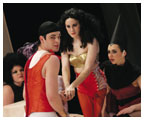 The Bacchae 2.17
The Bacchae 2.17
From left, Liz Abernethy ’07, Paulo Quiros ’06, Nicole Greenbaum ’07, and Alex Ripp ’08 during a rehearsal of The Bacchae 2.17, a student adaptation of a play by faculty member Charles Mee. (John Jameson ’04)
Few playwrights encourage directors to alter a single word of what they have written. By contrast, Charles Mee challenges performers to mix up and mess up, totally change, and rearrange his plays. As a visiting professor in the Program of Theater and Dance for the fall semester, Mee emphasized to his students that there is no such thing as an original play — even the earliest Greek tragedies, he notes, were based on earlier myths. He stresses, “Culture writes us first, and then we write our stories.”
A few of his students have put these lessons into practice. Greg Taubman ’06 and Paulo Quiros ’06 performed an adaptation of one of Mee’s plays, The Bacchae 2.1, as a senior thesis project sponsored by the Program in Theater and Dance. Students who are working on a certificate in the program may receive funding and other assistance, like professional design services and a campus venue. But most of all, the program grants students license to follow their own creative impulses. Taubman and Quiros named their production The Bacchae 2.17. As director Taubman explains: “ ‘The Bacchae’ because it is from Euripides, ‘2.1’ because Charles Mee has rewritten it, and ‘17’ because there are 17 of us working on this show.” The show was a collaborative effort in which actors added everything from poetry to advertisements and song lyrics to Mee’s original script, creating a fierce world of danger, love, and truth, as true to Mee’s play as to Euripides’ original.
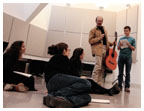 Patience
Patience
Lecturer David Kellett, holding guitar, with students, from left, Clare McNamara ’06, Lily Arbisser ’08, Amy Coenen ’07, Sean Effinger-Dean ’06, Michael Scharff ’08, and Sarah Vander Ploeg ’08, during a rehearsal of the Gilbert and Sullivan operetta, Patience. (John Jameson ’04)
Students in the course “Projects in Vocal Performance” rehearsed and performed the Gilbert and Sullivan operetta Patience during the fall semester — quite an undertaking, considering that classes met only twice a week for an hour and a half. “We’re working very hard and very fast,” said lecturer David Kellett, the stage director, who was teaching the course with music professor Richard Tang Yuk.
Patience, the sixth operetta written by William S. Gilbert and Sir Arthur Sullivan, lampooned the aesthetic movement of the late 19th century, but in order to give it a more modern interpretation, Kellett and Tang Yuk, who conducts the performances, set the operetta in the 1960s to poke fun at beatniks and hippies. (Even so, Kellett realized that the 1960s are as dim as the Victorian era to contemporary students.) The students were scheduled to perform the operetta in Richardson Auditorium during reading period, Jan. 13 and 14, accompanied by members of the Princeton University Orchestra with members of the Glee Club filling in parts of the chorus.
Fuzzy Dice, one of Princeton’s two student improv groups, performs at FluFest at Frist Campus Center in the fall. On the floor is Dave Kaplan ’06. Others are, from left, William Ellerbe ’08, Mark Bur ’08, George Lace ’08, Annie Haslam ’09, and Alex Limpaecher ’08. (John Jameson ’04)
Those people standing in the fountain outside Robertson Hall last spring were not just ordinary students on a romp. One was the ersatz superhero, “Can’t Get Wet Man,” who was performing with other members of the improvisational comedy team, Fuzzy Dice. One of two improv groups on campus (Quipfire! is the other), Fuzzy Dice is a self-styled “guerilla troupe” of 10 undergraduates whose made-up-on-the-spot performances leave audiences entertained, amused, or sometimes just scratching their heads. The fountain is one of the “nontraditional locations” in which Fuzzy Dice performs, says William Ellerbe ’08, the group’s vice president. They also have also shown up unannounced outside Frist Campus Center and staged a “Tour de Food,” enlivening study breaks at all five residential college dining halls.
In a representative improv routine, a pair of students will engage in some pantomimed activity, such as fishing. One will then toss out an unscripted line to which the other must respond, extending their conversation in some humorous way. The joke of “Can’t Get Wet Man,” Ellerbe explains, came from the absurd juxtaposition of seeing a hero — whose superpower is his supposed ability to stay dry — standing in the fountain, soaking wet. Though it may seem counterintuitive, improvisional groups do rehearse once a week, practicing different games and exercises to sharpen their ability to think on their feet and build camaraderie — to “cohesivify” the troupe, as Ellerbe puts it.
Bonus material online:
Watch Fuzzy Dice improvise—click
here.
 A cappella
A cappella
The Firehazards, who bill themselves as “Princeton’s newest and most unrehearsed group,” pose for The Rocky Horror Picture Show cast photo outside Theatre Intime. Front row, from left, are: Dan Candeto ’07, Ilana Lucas ’07, Patrick Taylor ’06, Kaitlyn Conway, Folasade John ’09, and Elissa Frankle ’07. Back row, from left, are: Jareth Holt ’09, Kate Rodbro ’06, Nick Pepersack ’07, Emily Aull ’08, Dana Fiero, Sophia Echavarria ’08, Jenna Moore, Dylan Tatz ’06, and Melissa Shulman ’07. (courtesy the Firehazards)
Nothing typifies a Princeton evening quite like an arch sing. Thirteen a cappella groups are registered this year with the Office of the Dean of Undergraduate Students. Although singing on the steps of Nassau Hall was a popular student diversion as early as the 18th century, organized a cappella groups are a relatively modern phenomenon; the oldest date back to the beginning of World War II. Today the arch sings by older and well-known ensembles are enlivened by new and distinctive groups. Koleinu performs a repertoire of songs mostly in Hebrew as well as one tune in English titled “Hebrew School Dropout.” Culturally Yours is an all-female group that performs only music written, performed, or popularized by people of African descent. The Firehazards, who do not hold auditions, bill themselves as “Princeton’s newest and most unrehearsed” group, and say they welcome persons of “all sexual orientations and gender identities.” In addition to the traditional arch sings before Christmas and on football weekends, the group stages an annual fall performance of The Rocky Horror Picture Show.
Wearing white cords signifying that they are beginners, Vera Kiss ’08, right, and Sarah Mannino dance in capoeira class in Dillon Gym last fall. Contra Mestre Zumbi, sitting in back, sings and plays the berimbau. (Frank Wojciechowski)
The drumbeat shakes the bones of the audience as the young woman steps forward to face her opponent. Low to the ground, the two kick and punch (rarely making contact) and twist in an elaborate dance. They are surrounded by a cheering circle of students, stamping and clapping, marking time with their instruments. This is capoeira, a form of art that combines the intricacies of dance and martial arts.
Originally a Brazilian slave dance, capoeira arrived at Princeton in the spring of 2002. More than 30 students now participate in extracurricular classes led by a teacher known only as Contra Mestre Zumbi. They perform by forming dance circles, called rodas. Someone in the circle creates a rhythm with a berimbau, a Brazilian instrument that looks like a strung wooden bow. Dancers take turns entering the circle and interacting with each other. Itamar Bar-Zakay ’08, a member of Princeton Capoeira for almost two years, describes the roda in this way: “There are the same kicks and movements as the basics in practice, but each person decides what to do next according to what he feels like, according to what the other person is doing, and very importantly, according to the energy and feel of the game. So every game can develop into very different things. Nothing is planned in advance.” The unpredictability of capoeira’s aggressive but beautiful movements makes it an increasingly popular art form on campus.
Bonus material online:
Watch Capoeira footage
online—click here.
![]()
Bridget Reilly Durkin ’07 is a PAW intern.
Mark F. Bernstein ’83 is PAW’s senior writer.

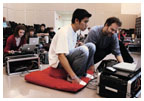 Princeton Laptop Orchestra
Princeton Laptop Orchestra
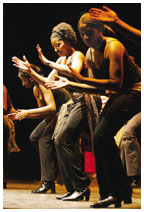 High Steppers
High Steppers
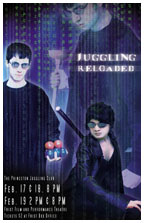 Princeton Juggling Club
Princeton Juggling Club
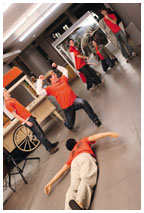 Fuzzy Dice
Fuzzy Dice
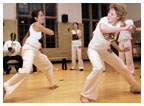 Capoeira
Capoeira